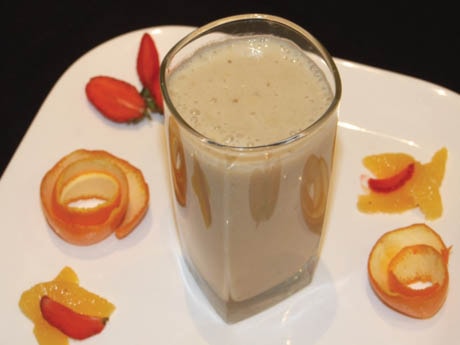Frosty, dessert-like and packed with delicious, nutritional ingredients, it’s no wonder fruit smoothies are so popular.
What’s particularly nice about smoothies is that they are fast and easy to make, and indulgent without being loaded with fat and calories. Plus, the only equipment you need is a blender.
Of course, a smoothie is only as healthy and tasty as the ingredients you put in it. So avoid dumping in sugar or thickening with full-fat dairy products. There are easy, healthy alternatives.
To give a fruit smoothie its icy, thick consistency, use crushed ice or frozen fruit as the base. The advantage of ice is that you add volume and texture without calories. The downside is that your smoothie can become watery as the ice melts.
Thickening with frozen fruit adds calories, but also plenty of vitamins, fibre and antioxidants.
For convenience, wash, cut and freeze fruits such as melons, stone fruits and berries when they are in season so you have them on hand when smoothie inspiration hits.
Peeled and cut tropical fruits, such as bananas, pineapples and mangoes, also are great ingredients to keep in the freezer.
For greater convenience, use store-bought frozen fruits, such as berries, cherries and peaches. These usually are an excellent value and good enough quality for blending into smoothies.
Be sure to buy individually quick-frozen fruits rather than those frozen in blocks of sugary liquid. They are healthier and much easier to toss into the blender.
Many fruit smoothies also contain milk or frozen yogurt to give them a thick, creamy, milkshake-like texture. These two smoothie recipes go a little out of the box by using non-fat buttermilk to add a rich-tasting, pleasant tang.
The strawberry-banana smoothie uses frozen berries and fresh bananas, which add additional creaminess. Antioxidant-rich blueberries and pomegranate juice make a shocking purple smoothie that’s as healthy as it is flavourful.
Use leftover buttermilk to make dressings, marinades or as a healthy ingredient in baked goods, such as biscuits and cakes.
Consider the salt in these recipes optional. Just a pinch heightens the flavours of the fruit without adding much sodium.
Strawberry-Banana Smoothie
375 ml (1 1/2 cups) unsweetened frozen strawberries
2 small bananas, broken into chunks
125 ml (1/2 cup) non-fat buttermilk
5 ml (1 tsp) vanilla extract
Pinch salt
In a blender, combine all ingredients and blend until smooth.
Makes 2 servings.
Nutrition information per serving (values are rounded to the nearest whole number): 158 calories, 4 calories from fat, 0 g fat (0 g saturated, 0 g trans fats), 1 mg cholesterol, 37 g carbohydrate, 4 g protein, 5 g fibre, 327 mg sodium.
Blueberry-Pomegranate Smoothie
375 ml (1 1/2 cups) frozen blueberries
250 ml (1 cup) pomegranate juice
125 ml (1/2 cup) non-fat buttermilk
5 ml (1 tsp) vanilla extract
Pinch salt
In a blender, combine all ingredients and blend until smooth.
Makes 2 servings.
Nutrition information per serving (values are rounded to the nearest whole number): 151 calories, 7 calories from fat, 1 g fat (0 g saturated, 0 g trans fats), 1 mg cholesterol, 34 g carbohydrate, 4 g protein, 3 g fibre, 339 mg sodium.
